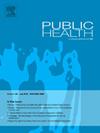A policy perspective on household food security measures (extent, severity, and correlates): A population-based survey in Western Australia
IF 3.2
3区 医学
Q1 PUBLIC, ENVIRONMENTAL & OCCUPATIONAL HEALTH
引用次数: 0
Abstract
Objectives
To compare the extent, severity and correlates with household food insecurity among Western Australian adults using the U.S. and Canadian Household Food Security Survey Module (HFSSM) coding systems and assess their suitability for government policy considerations.
Study design
Continuous cross-sectional population representative computer-assisted telephone interviews.
Methods
Between 2017 and 2021, the United States Department of Agriculture's HFSSM was added to the Western Australian Health and Wellbeing Surveillance System in addition to the usual single item measure. Weighted population estimates of the extent and severity of food insecurity were calculated (n = 8684 households), and demographics, socio-economic and lifestyle-related health risk factors were analysed using bivariable regression models, with multivariable models fitted to assess associations for both the U.S. and Canadian coding systems.
Results
Food insecurity prevalence was 3.0, 3.6 and 5.1 percent using the single item, U.S. and Canadian schemes, respectively. There are significant differences between HFSSM classification schemes (p=0.04), the U.S. reported 1.8 % for both of moderate and severe, compared to 3.4 % moderate and 1.7 % severe with the Canadian. A significantly higher proportion of food insecurity was reported among households with children. Both systems found significant positive associations with inability to save money, low educational attainment, low income, not owning a house, higher Body Mass Index, stressful life events, and psychological distress (p<0.05), with the strength of associations lower using the Canadian system.
Conclusions
Dimensionality and thresholds applied in HFSSM classification influence the extent and severity of food insecurity reported. Robust definition of the policy problem, the first step in policy deliberations, is critical. Findings highlight the importance of instrument and choice of classification scheme in defining the problem and the inadequacy of the single item measure routinely used in Australia.
家庭粮食安全措施的政策视角(范围、严重性和相关性):西澳大利亚州一项基于人口的调查
目的使用美国和加拿大家庭食品安全调查模块(HFSSM)编码系统,比较西澳大利亚成年人家庭食品不安全的程度、严重程度及其与家庭食品不安全的相关性,并评估其对政府政策考虑的适用性。研究设计连续横断面人口代表性计算机辅助电话访谈。方法在2017年至2021年期间,除了通常的单项措施外,美国农业部的HFSSM还被添加到西澳大利亚州健康和福祉监测系统中。计算了粮食不安全程度和严重程度的加权人口估计值(n = 8684户),并使用双变量回归模型分析了人口统计学、社会经济和生活方式相关的健康风险因素,并拟合了多变量模型来评估美国和加拿大编码系统的关联。结果采用单项方案、美国方案和加拿大方案的食品不安全患病率分别为3.0%、3.6%和5.1%。HFSSM分类方案之间存在显著差异(p=0.04),美国报告的中度和重度均为1.8%,而加拿大报告的中度和重度分别为3.4%和1.7%。据报告,在有子女的家庭中,粮食不安全的比例明显更高。两种系统都发现,没有能力存钱、受教育程度低、收入低、没有房子、身体质量指数高、生活压力大和心理困扰显著正相关(p<0.05),使用加拿大系统的关联强度较低。结论HFSSM分类中应用的维度和阈值影响粮食不安全报告的程度和严重程度。政策问题的明确定义是政策审议的第一步,这一点至关重要。研究结果强调了工具和选择分类方案在定义问题方面的重要性,以及澳大利亚常规使用的单项措施的不足。
本文章由计算机程序翻译,如有差异,请以英文原文为准。
求助全文
约1分钟内获得全文
求助全文
来源期刊

Public Health
医学-公共卫生、环境卫生与职业卫生
CiteScore
7.60
自引率
0.00%
发文量
280
审稿时长
37 days
期刊介绍:
Public Health is an international, multidisciplinary peer-reviewed journal. It publishes original papers, reviews and short reports on all aspects of the science, philosophy, and practice of public health.
 求助内容:
求助内容: 应助结果提醒方式:
应助结果提醒方式:


